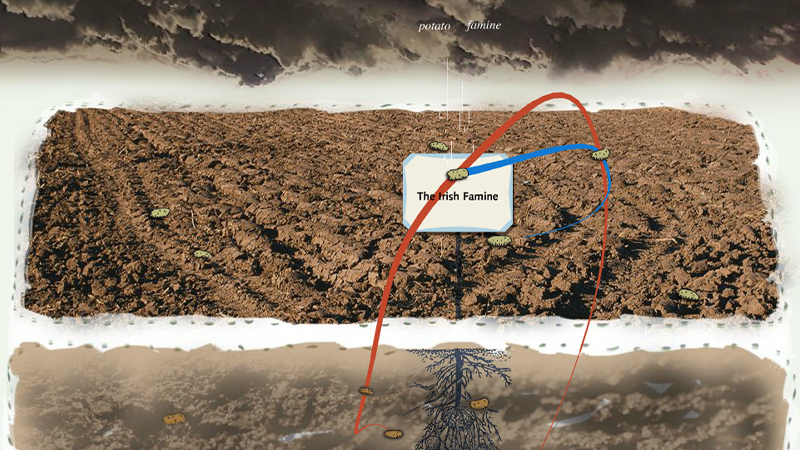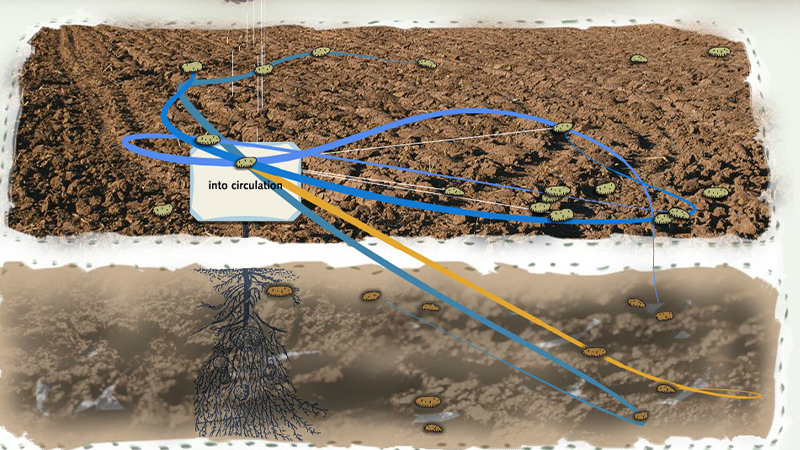"If 'mobility' seems very much a buzz word of the new millennium, packaged and sold to us via an ever-increasing array of sleek and shiny devices, Mobile Figures insists we think the term historically and culturally by routing us back to an earlier place and time. The piece explores a series of contradictory figurations of the Irish during the period of the Famine in order to understand the work such representations perform for capital, for empire, and for the Irish themselves. As such, Mobile Figures sheds light on our contemporary moment of globalization, as the 19th-century movements of the Irish provide one trajectory through which we might historicize and analyze the accelerated processes of diaspora and displacement that so characterize late capitalism.
In an early design meeting for the project, David Lloyd expressed the hope that the piece might produce in the reader a feeling akin to dropping into a bog, a sense of displacement and radical reorganization. As such, he was interested in mining the affective registers of argument set free from the strict linearity of the traditional essay, opening up the possibility for contingency, juxtaposition, accident, and meandering as modes of scholarly engagement. Through a process of iterative collaboration, Creative Director Erik Loyer and Lloyd have succeeded in modeling a more rhizomatic form of scholarship that simultaneously sustains linear argument and pushes hard against it. In deploying this 'both/and' logic, the piece points to new modes of historiographic inquiry by forging points of intersection between oft-distinct modes of thought, linking up political economy, visual culture, literary theory, and an investigation of subaltern agency. It creates a space for those associative lines of thought that regularly get pruned away as we force our ideas into the confines of linear print. Through the Vectors collaboration process, it also became clear that Lloyd was unearthing fresh dimensions to his argument, allowing a new 'form' to reshape what he could do and say with 'content' he knew quite well.
Such a multi-layered structure is exquisitely appropriate to the subject matter at hand, for one of the lessons of the piece is to remind us that the Irish were at once reified in their figuration by the British and always also outstripping that very fixity, enabling and escaping the logics and rationalizations of capital at one and the same time. In their mobility and their stasis, the Irish limn both the dream of perfect abstract labor and the impossibility of that dream's full realization." – Vectors Journal Editorial Staff
Author's Statement
"'Crowds of miserable Irish darken all our towns.' 'Ireland has poured forth the most destitute of her hordes to supply the constantly increasing demand for labour.' In phrases such as these, social commentators in 19th century Britain as diverse as the critic Thomas Carlyle and the social reformer James Kay register the disturbing presence of the migrant Irish. Possibly no population in the nineteenth century was more mobile than the poor Irish who, even before the disastrous Famine of 1845-1851, were given to seasonal and sometimes permanent migration to Britain and further afield, in search of work to see them through the months when the potato crop was exhausted or as a population displaced by agricultural rationalization. Their mobility was disturbing to English observers for several reasons. In the first place the 'contagious example' of their modes of life was seen as threatening to infect and corrupt the manners of the English working class, lowering their living standards and expectations as well as their rates of wages. The migrant Irish were also assumed literally to bear with them disease and contagion, their dunghills being held to be the source of the 'miasmas' from which pestilence was supposed to arise.
The Irish also present, however, a source of discursive disturbance. For political economy, they are a theoretical anomaly, surviving in excessive numbers on a subsistence crop whose abundance defies the laws of economics and supports a laboring population far in excess of the available capital. More than that, they trouble the very axes of language itself. The recurrent figures of Irishness—the potato, dung and miasma—are metaphors that are simultaneously metonyms, identities that fix them yet that are modes of displacement. The Irish as peasants are like potatoes off which they live, by which they live: stolid, lumpish, confined to the local, yet like the potato they spread and proliferate wildly in a rhizomatic process of reproduction—in a metonymic movement. Like the dung in contiguity with which they live, they are a waste, redundant matter, but one also which oozes and flows to contaminate whatever it touches. They move, contagiously, like the miasmas that emanate from them. In this perpetual shift between metaphor and metonym, the Irish become the mimics of the system of exchange itself, in which commodities occupy simultaneously the axes of likeness and of substitution. Caught in the dispossessing displacements of primitive accumulation, and thrown on the labour market as that ultimate commodity, abstract labour, the mobile Irish who seem so peripheral and backward in relation to capitalism, become the parodic double of its own vertiginous and destabilizing flows.
Mobile Figures seeks not only to present an account of Irish mobility in the nineteenth century, but to enact that mobility and its effects. Structured around the three tropes of Irishness, potato, dung and miasma, the text constructs a rhizomatic network of movements between nodes of argument, archival material and amplifying commentary. These nodes are linked at once metonymically, in the sense that a set of syntagms or threads link steps in the argument to one another, and metaphorically, in that the citations construct a web of paradigmatic statements, both about the Irish and about the figures that inscribe them in a network of associations. Although the text can be read as a series of propositions organized within a linear argument and supported by evidentiary material, it can also be read as a potentially inexhaustible fabric of associative threads, each node of which branches into other sets of association. Such a text seeks to use the possibilities of web publication to enact the processes that a standard print-medium essay would only describe. It is consequently necessarily experimental and open-ended, doubtful as it is that an exhaustive set of associations could be established. Ideally, indeed, this is a text that would invite supplementation, the reader being invited to add citations and commentary that would extend the schematic net of associations established here, no restriction on legitimate and illegitimate associations being in principle possible, and each node opening onto fields that surely exceed the purview of any single 'author'." -- David Lloyd, Vectors, Volume 1, Issue 2, Spring 2006
Designer's Statement
"From
the outset it was clear that David Lloyd, self-described 'technopeasant,' had been ready for quite some time to write through a
database. One of the joys of this project was working to create an
environment that would accommodate his almost gleeful willingness to
remake his scholarly work using the tools of interactive media.
Interactive
projects like this one, whose content begins life in another medium,
are inevitably about 'slice and dice,' or how to chop up the content
into atomic chunks that can be tagged, sorted and categorized. This
must be done so that the computer can have some 'understanding' of the
content and thus react intelligently when the user interacts with that
content. The process is often accompanied by an understandable fear on
the part of the author. Not in David's case, however, and for this I'm
grateful, not just because his adventurousness made our collaboration
easier, but also because it allowed me to focus on the more constructive
aspects of the design. In other words: now that we've atomized the
content, how do we put it back together?
Quite early on we
decided that the database design would lead everything else, and after a
few initial meetings, the structure of the piece's content as a
collection of annotated nodes and threads started to suggest itself.
Very quickly, and with minimal visual exploration having been done, we
had the database up and running, along with a set of entry tools created
by Craig Dietrich, to whom both David and I are heavily indebted.
At
this point, David was able to begin entering his content directly into
the database, while I developed the functionality and look of the piece
simultaneously. It was a tremendously liberating, if somewhat
frightening, way to work. Allowing for maximum flexibility, the
database was intentionally loaded with more structures than we would be
likely to use, and those structures could be fruitfully interpreted in
multiple ways by the program I was writing. Often David and I would wind
up in extended e-mail discussions about the particulars of how this or
that piece of data should be entered by him and acted upon by the piece.
At times it felt as if we were swimming through endless layers of
abstraction, looking for resonances even down to the level of the
meaning of individual words—anything that would be a useful foundation
upon which to build our lattice of content.
This process of
construction was for me the most enjoyable and fruitful part of the
project, because it was fundamentally about revealing aspects of David's
work that might previously have remained buried, owing to the demands
of linearity. This unearthing of process as well as of content was, I
think, mutually encouraging: at the end of one meeting David mentioned
that he eventually wanted to use the database to write poetry. Since
enabling writing is, in a way, the central mission of Vectors, hearing a
comment like that couldn't have made me happier." -- Erik Loyer, Vectors, Volume 1, Issue 2, Spring 2006
"David Lloyd
Author
Professor of English at the University of Southern California since 2003, David Lloyd has published primarily in the field of Irish literature and culture and on colonialism and nationalism. His books in Irish Studies are: Nationalism and Minor Literature: James Clarence Mangan and the Emergence of Irish Cultural Nationalism, (1987); Anomalous States: Irish Writing and the Postcolonial Moment (1993); Ireland After History (2000); and a special issue of Interventions, 'Ireland's Modernities' (2003). He is currently at work on a further book, A History of the Irish Orifice: the Irish Body and Modernity. He has co-published several other books: The Nature and Context of Minority Discourse, co-edited with Abdul JanMohamed (1991); The Politics of Culture in the Shadow of Capital, co-edited with Lisa Lowe (1997); and Culture and the State, co-authored with Paul Thomas (1997). He is also working on a study of culture and ideology, Aesthetic Education: the Cultural Formation of the Subject. He teaches on Irish literature, cultural and postcolonial theory and British and Anglophone literature from Romanticism to the present. He joined USC in Fall 2003 after teaching at Scripps College, Claremont, and the University of California, Berkeley.
Erik Loyer
Designer Programmer
Erik Loyer's interactive artworks have been exhibited online and in festivals and museums throughout the United States and abroad, including the Museum of Contemporary Art, Los Angeles; the Prix Ars Electronica; and Transmediale. Loyer is the creator of The Lair of the Marrow Monkey, one of the first websites to be added to the permanent collection of a major art museum, and Chroma, an award-winning web serial about the racial politics of virtual reality. As Creative Director for Vectors, he has designed numerous multimedia essays in collaboration with leading humanities scholars. Loyer's commercial portfolio includes Clio and One Show Gold Award-winning work for Vodafone as well as projects for BMW and Sony. He is the recipient of a Rockefeller Film/Video/Multimedia Fellowship, and his works have been honored in the Montreal International Festival of New Cinema and New Media and the California Design Biennial. Loyer has a B.A. in Cinema/Television Production from the University of Southern California." -- from Vectors, Volume 1, Issue 2, Spring 2006
1 COPY IN THE NEXT
Published in Spring, 2006 by Vectors in Volume 1, Issue 2.
This copy was given to the Electronic Literature Lab by Erik Loyer in November of 2021.
PUBLICATION TYPE
Online Journal
COPY MEDIA FORMAT
Web


